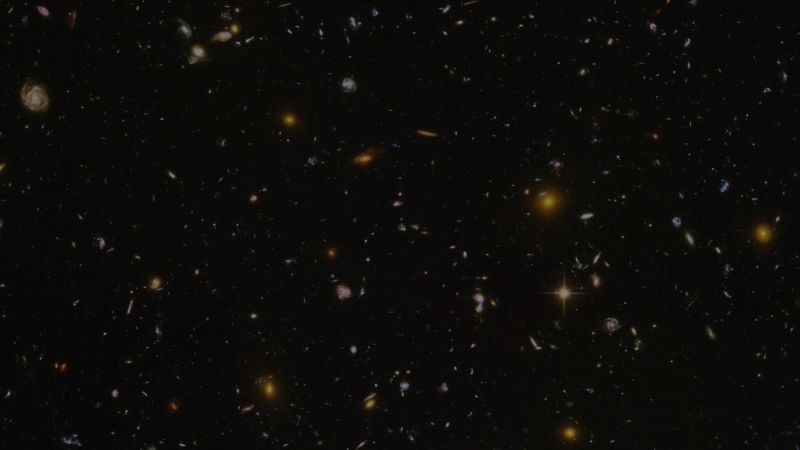Israel’s military leaders signal their work in Gaza and Lebanon is done. Will Netanyahu listen?
Astronomers say they’ve traced the origin of powerful and mysterious radio signal


Astronomers have traced one of the most powerful and distant fast radio bursts ever detected back to its unusual cosmic home: a rare “blob-like” group of galaxies. The unexpected discovery could shed more light on what causes the mysterious radio wave bursts, which have puzzled scientists for years.
The intense signal, named FRB 20220610A, was first detected on June 10, 2022, and it traveled 8 billion light-years to reach Earth. A light-year is the distance light travels in one year, or 5.88 trillion miles (9.46 trillion kilometers).
Fast radio bursts, or FRBs, are intense, millisecond-long bursts of radio waves with unknown origins. The first FRB was discovered in 2007, and since then, hundreds of these quick, cosmic flashes have been detected coming from distant points across the universe.
This particular fast radio burst lasted less than a millisecond, but it was four times more energetic than previously detected FRBs. The burst released the equivalent of our sun’s energetic emissions over the course of 30 years, according to an initial study published in October.
Many FRBs release superbright radio waves lasting only a few milliseconds at most before disappearing, which makes them difficult to observe.
Radio telescopes have proved helpful in tracing the paths of the quick cosmic flashes, so researchers used the Australian Square Kilometre Array Pathfinder, or ASKAP, radio telescope in Western Australia and the European Southern Observatory’s Very Large Telescope in Chile to determine where the enigmatic burst originated.
The observations led scientists to a giant celestial blob, which initially was thought to be a single irregular galaxy or a group of three interacting galaxies.
Now, astronomers have used images from the Hubble Space Telescope to reveal that the fast radio burst came from a group of at least seven galaxies that are so close to one another that they could all fit inside the Milky Way galaxy.
The findings were presented Tuesday at the 243rd meeting of the American Astronomical Society in New Orleans.
An unusual galactic group
The galaxies in the group seem to be interacting and could even be in the process of merging, which might have triggered the fast radio burst, according to the researchers.
“Without the Hubble’s imaging, it would still remain a mystery as to whether this FRB originated from one monolithic galaxy or from some type of interacting system,” said lead study author Alexa Gordon, a doctoral student in astronomy at Northwestern University’s Weinberg College of Arts and Sciences, in a statement.
“It’s these types of environments — these weird ones — that drive us toward a better understanding of the mystery of FRBs.”
The galactic group, known as a compact group, is exceptional and an example of the “densest galaxy-scale structures we know of,” said study coauthor Wen-fai Fong, an associate professor of physics and astronomy at Northwestern and Gordon’s adviser.
As the galaxies interact, they could trigger bursts of star formation, which could be linked to the burst, Gordon said.
Fast radio bursts have largely been traced back to isolated galaxies, but astronomers have also found them in globular clusters, and now, a compact group, Gordon said.
“We just need to keep finding more of these FRBs, both nearby and far away, and in all these different types of environments,” she said.
Investigating the origins of fast radio bursts
Nearly 1,000 fast radio bursts have been detected since their initial discovery about two decades ago, but astronomers remain unclear on what causes the bursts.
But many agree that compact objects, such as black holes or neutron stars, the dense remnants of exploded stars, are likely involved. Magnetars, or highly magnetized stars, may be the root cause of fast radio bursts, according to recent research.
Understanding where fast radio bursts originate from could help astronomers determine more about the underlying cause that sends them streaming across the universe.
“Despite hundreds of FRB events discovered to date, only a fraction of those have been pinpointed to their host galaxies,” said study coauthor Yuxin Vic Dong in a statement. “Within that small fraction, only a few came from a dense galactic environment, but none have ever been seen in such a compact group. So, its birthplace is truly rare.” Dong is a National Science Foundation graduate research fellow and doctoral student of astronomy in Fong’s lab at Northwestern.
More insights about fast radio bursts could also lead to revelations about the nature of the universe. As the bursts travel through space for billions of years, they interact with cosmic material.
“Radio waves, in particular, are sensitive to any intervening material along the line of sight — from the FRB location to us,” Fong said. “That means the waves have to travel through any cloud of material around the FRB site, through its host galaxy, across the universe and finally through the Milky Way. From a time delay in the FRB signal itself, we can measure the sum of all of these contributions.”
Astronomers are anticipating increasingly sensitive methods of detecting fast radio bursts in the future that could lead to discovering more of them at greater distances, Gordon said.
“We are ultimately trying to answer the questions: What causes them? What are their progenitors and what are their origins? The Hubble observations provide a spectacular view of the surprising types of environments that give rise to these mysterious events,” Fong said.











